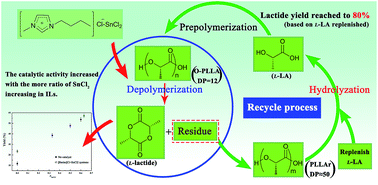Synthesis of chlorostannate(ii) ionic liquids and their novel application in the preparation of high-quality l-lactide†
Abstract
Polylactic acid (PLA) is a representative biodegradable polymer, which is expected to be a promising replacement for some petroleum-based materials. Noticeably, the properties of PLA products depend strongly on the quality of the lactide monomer, a crucial precursor of PLA production. In this work, a large range of different chlorostannate(II) ionic liquids (ILs), prepared by mixing 1-butyl-3-methyl-imidazolium chloride and tin(II) chloride in various molar ratios, xSnCl2, were firstly applied for the preparation of L-lactide of high chemical and optical purity. The cation–anion interaction, the thermal stability and the acidity of imidazolium-based chlorostannate(II) ionic liquids were experimentally determined and systematically analyzed. Compared with the conventional SnCl2 catalyst, the depolymerization of oligomeric poly(L-lactic acid) catalyzed by chlorostannate(II) ionic liquids occurred in a moderate yield. Interestingly, using [Bmim]Cl–SnCl2 (xSnCl2 = 0.63) as a catalyst, L-lactide of 99.9% optical purity was obtained, simultaneously leaving a high-Mw oligomeric residue with high isotacticity (99.1%). Furthermore, the effects of various reaction parameters were investigated in order to obtain the highest possible yield of lactide. A plausible reaction mechanism was suggested and discussed. Finally, owing to the reutilization of PLLA residue of high isotacticity, a reiterative lactide synthesis was realized. The recycled catalyst showed no notable loss of activity. By combining this chlorostannate(II)-based IL (xSnCl2 = 0.63) catalyst technology with the cyclic resynthesis process, high-quality L-lactide could be selectively produced in high yield (>80%, based on L-lactic acid replenished).


 Please wait while we load your content...
Please wait while we load your content...